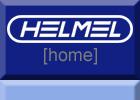 |
|
 |
 |

|
|||||||
 |
|
Intrinsic Accuracy means that the CMM accuracy specifications are met by virtue of the physical and mechanical precision and repeatability of the machine structure, geometry and scales. You can measure accurately with just the Digital Readout and hard probes, or with dial or electronic indicators. The machine is constructed and assembled to be straight, square, stable and has accurate measuring scales.
By contrast, a CMM can be constructed and assembled less conscientiously, and may be physically straight and square to only a few or even many thousandths of an inch. This would be a terrible CMM, but it can be fixed. By use of a laser or other instruments the specific inaccuracies of the machine can be measured and detected throughout the machine volume. The volume can be gridded or "mapped" by software, and corrections can be made for any position in the volume. Thus, measurement results can be compensated for, and accuracy can be produced. There is nothing inherently wrong with this electronic error compensation provided it is not used as a quick fix to cover up machine deficiencies. If a CMM measures accurately with error comp, and meets specification, then why worry whether the machine is intrinsically accurate? Here are some points to consider : • The uncompensated accuracy of a CMM is an indication of the quality of the underlying product. It is much more difficult to produce a CMM with uncompensated volumetric accuracy of .0005" than .005", obviously. To achieve it, each component must be made to exacting standards, and checked closely. Extreme care must be taken in assembly so that axes are set perfectly straight and square to each other. Every bearing must be tested and hand selected, and the same applies to the measuring scales. Mounting surfaces, guide ways, or both may have to be hand lapped to produce the necessary precision. With every element subjected to severe scrutiny, and the ultimate assembly tested throughout every position along the length of travel repeatedly, only a product of the highest quality can make it to the shipping dock. • A lesser machine can be assembled with less precise, even lower quality components, by far less skilled people. It can be assembled without great concern for its raw performance or precision, because everyone involved in the process understands that at the end of the line, any flaws or inaccuracies, even poor component or assembly quality, can be "fixed" with a laser, computer and software. So even though the uncompensated accuracy of the lesser machine might be .005", it can be error compensated so that the sales literature can rightfully proclaim a volumetric accuracy of .0004" ! One could easily be fooled into thinking that this, therefore, must be a "better" machine than the equivalent CMM claiming only .0005" accuracy, even though the later machine offers intrinsic mechanical accuracy. Perhaps, but for how long ? If the lesser machine is serviced or repaired, can you be certain that the measured inaccuracies are exactly where they were before? Remapping the compensation grid will be necessary, and this is expensive, and might only be done by a factory service person. This same point applies to the calibration interval. The machine can't be calibrated in a conventional way, and will require the costly regridding procedure. In a CMM system, the machine is a relative constant over years. Measurement software changes rapidly, and software system upgrading at some point is almost a certainty. A machine with poor intrinsic accuracy will limit your choices to systems that can provide competent error comp, and maybe to only that offered by the CMM manufacturer, and these may not otherwise be the preferred systems. Systems fail and computers fail. Your CMM should be able to produce usable accuracies even if the error compensation is not operable. It's an insurance policy. Collisions occur, especially on DCC CMMs. The first thing that suffers is usually the squareness of the axes to each other. A simple re-squaring procedure should put the CMM back into specification. This is not possible in most cases, where computer compensation is applied. A costly re-mapping procedure by the manufacturer has to remedy the situation. What about the philosophy behind the machine design and execution? If one considers the reasons why a CMM manufacturer would choose to build, on the one hand, a machine with high intrinsic accuracy, or on the other hand, a lesser product with a software fix, one should rightfully conclude that the first manufacturer sees his purpose as producing a CMM of the highest quality and reliability, a righteous machine. The second manufacturer is very likely more concerned with profits and moving units. Most high quality CMMs use error compensation only as the icing on the cake. They are mechanically sound, built to the best accuracies possible and only the last wrinkles are taken out by compensation. When buying a CMM, it is strongly recommended that you request of the CMM manufacturer a statement of both error compensated accuracy, and Uncompensated, Intrinsic Mechanical Accuracy. Peel back the veneer of the software fix and unmask the quality of the machine beneath. What are you spending good money on? The accuracy of a good machine can be improved by a factor of 2 or 3 with error compensation. If you see ratios of 10, 15, or even 20 to 1, either you are overpaying or you are buying and inferior product. Buy a machine that is built right first, and it will be a pleasure to own and operate for decades. |
|
|